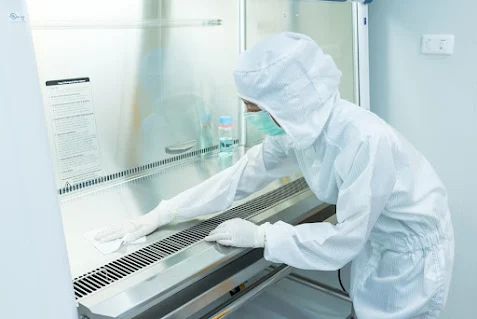Gel Documentation System measures
and records labeled protein and nucleic acid; different media like
acrylamide, cellulose, or agarose are used for the diagnosis. The
equipment aids in quick evaluation after electrophoresis which proves to
be economical in terms of chemical and time. You can see the results in
less than five minutes through stain-free technology. This testing
equipment is used in research labs that help you to visualize
photo-documented nucleic acid separated samples taking place after
electrophoresis, show microbial colonies count and protein separation on
western blots, and thin layer chromatography (TLC) mixture
identification.
What is the basic working of a Gel Imager?
The gel imager comes with an ultraviolet (UV)/ visible (blue or white) transilluminator. The light source is blocked from penetrating with a hood and inside the equipment; a high-resolution camera captures the image. The procedure involves samples mixed with the agarose gels placed on a Petri dish or TLC films, placed on the transilluminator surface. The door closes down and prevents the UV light from penetrating outside harming the user. Once the lamp is powered the photo documenting through CCD and CMOS cameras takes place. The images can be retrieved and exported on Microsoft Excel.
Labs that use the gel images
Used in molecular biology labs for genomics, proteomics, the imaging system identifies PCR segments with DNA quantification, bacterial cell culture, protein separation, and environmental sample testing. Emitting visible light or Ultra Violet light for visualizing chemiluminescent samples or bacterial sample count, the UV light should match the absorption spectrum of the fluorescent dye used at the time of gel separation through a blotting and thin chromatography process. For colony counting at its optimal amount, the blue light emitted at 470 nanometers and staining samples through commercial dye commonly use SYBR Green, SYBR Gold, or SYBR Safe. Visualize, UV 254 nanometer light at its optimal amount to identify DNA cross-linking, for short exposure gels, stained with Ethidium Bromide 302 nanometer light is best suited and for gel band cutting, 365 nanometer light suits perfectly.
Gel Documentation System Application and uses
B1 - horizontal minigel system
For identifying DNA and RNA samples for analysis, cloning, and sequencing, samples of DNA and RNA (Necluic acids)are loaded on agarose or acrylamide gel. Exposing them to the electric field, the negatively charged samples travel towards the positive electrode. The smaller DNA and RNA fragments travel faster than the longer ones, enabling fragment identification aided by the fluorescent dyes. Once identified, the samples are separated for purification.
B2 - horizontal minigel system
The protein sample is immersed in Tris-Glycene or Tris-Acetate– Tris-Glycene or Tris-Acetate which is commercially available and is effective in purification and separation. The protein fragments travel at different speeds through the gel metrics. Mass spectrometry, sample denaturing, and blotting use the protein gel.
B3 Colony counting
Microbial colony-forming units’ optimal growth is determined within the petri dish that has cell media loaded in it.
B4 Thin layer Chromatography
Quantification and qualification of a mass of substances include lipids, carbohydrates, fatty acids, and pesticides.
B5 Southern and Western Blot Gel
Separates proteins and isolates them for purification of active gels and SDS-PAGE gels.
Southern Blotting Gels
Separation of DNA fragments from blood and tissue samples restricting enzyme digestion through polyacrylamide (PAGE) gels and sodium dodecyl sulfate (SDS) gels combining urea.
Conclusion
A necessity for any lab that demands protein analysis, the imaging system comes in a range of specifications. However, you can customize the level of application if you order your gel imager from iGene Labserve. Visit our website and get in touch for details https://www.igenels.com/. You can also explore our gallery of scientific equipment to expand your lab assets.







